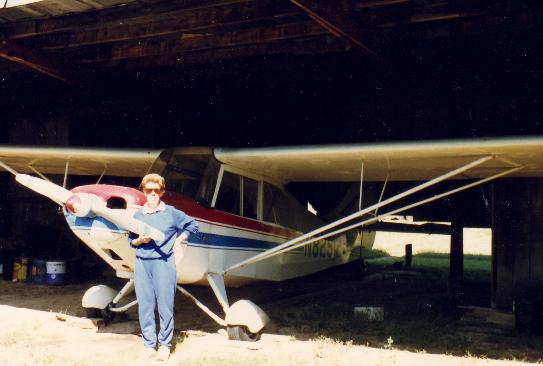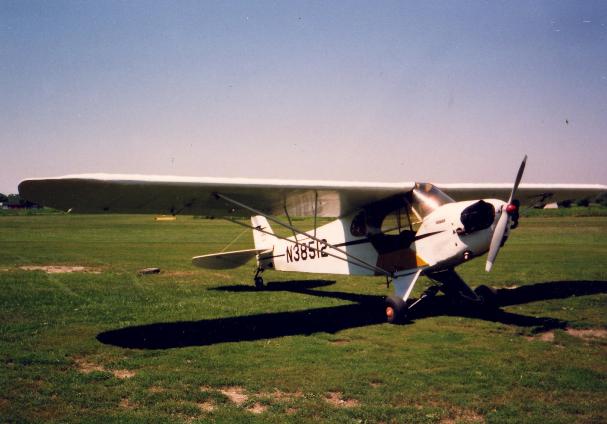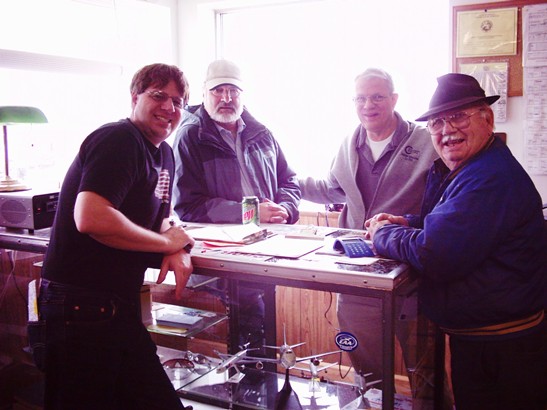The Joy Of Flying & Learning In Taildragger Planes.
As a pilot if you would like to learn how to fly these amazing old taildragger planes from yesteryear. Just take a look around the old country Airports that are still here and there, and you will soon find them. When I was young and just learning how to fly half the fun was walking around the Airport and looking at all those beautiful classic planes. I would stand there and look at them, wondering where they had been, if only they could talk and tell there tales of wonder and adventure!
I believe the best places to go for Taildragger Instruction are your smaller outside the city Airports. Out at those older strips you can also find some real gems to fly. planes like the Piper Cub or Aeronica Champ which are a pleasure to fly. Here is a picture of my mother posing beside the old Champ that I use to fly. I have about 20 hours flying this beautiful plane, all around Southern Indiana & Northern Kentucky. I spent many of those hours just flying over the river low and slow between the hills on each side of the banks enjoying the view & tranquility.

Frank Robinson and old instructor from World War II, taught me how to fly this Taildragger. He had a grass strip on his property located right beside the Ohio River. It was an East & West runway about 1400 feet long with trees at one end. After taking off we headed south to another grass field in Northern Kentucky. This is where I learned the art of 3 point landings. Once I had mastered them Frank began teaching me the finer points of wheel landings, boy was that fun. But, as any pilot can attest, they can be quite challenging when you first begin learning them.
You see when doing a wheel landing, you have to fly the plane in with a little extra speed. Then get as close to the ground as you can, and just before your main wheels touch ease the stick forward to plaster the wheels to the ground. But if you miss time this, you will bounce. This is what makes these type landings so difficult to learn. But believe me, once you get them figured out, they are incredibly fun and challenging to do. As a pilot, You quickly come to love those old and wonderful taildraggers!!
My old Instructor Frank Robinson taught Basic Flight to many of the young cadets during World War II in taildraggers just like this one. He was quite a man, I could listen to him tell his flying stories from the past all day long. I was very fortunate to have 3 different instructors from the War years teach my father and I how to fly. They have all passed away now, but will never be forgotten for there service to the country or the good times we shared flying together.
Here is another old bird that my Father and I enjoyed flying together the Historic J3 Cub. If you ever have the opportunity to fly one of these, do it, you would be flying a piece of history. They may not be fast but you would have the time of your life. You know honestly, when it comes right down to it, these old antique, classic planes are more fun than any others out there. Taildraggers are simple, fun, forgiving, and a pleasure to fly. After all, that is why we got into flying in the first place, right!!

Another one of my older Instructors Named Shorty Graves taught me how to fly this J3 Cub, he has now passed away. But he left his flying spirit in all of us he trained over the years. The Airport he taught out of is now a neighborhood, you can't even tell it was ever there. This is happening at a freighting rate all over the United States. Many of the young men and woman will never have the opportunities we older pilots had in the past.
Shorty was a true Pilot with great stories, he was an FAA Flight Examiner, Flight Instructor, and A&P for much of his life. Back in the day when he was younger. He took off in the J3 Cub from Indiana much like the one above and flew all the way down to the tip of South America and back home again. Can you just imagine what an adventure that must have been & the flying stories he had to tell!! Here was a man that had truly done it all, and I had the pleasure and honor of being both his student and friend for many years.

Left to right is me, A fellow pilot, my father, and Shorty Graves. Shortly after this picture was taken, Shorty passed away. But he will never be forgotten by any who knew him and shared the skies with him! I still rememeber to this day, how often he would tell me the throttle controls the altitude, and the elevator controls the speed. He would be setting behind me in those old Trainers of his, chewing his cigar and patiently teaching away.
When taking flying lessons from Shorty Graves you learned the way they use to teach back in the past. You did not fly big Traffic Patterns you flew a very tight pattern in case your engine quit. When flying if you needed more speed you simply lowered the nose and there it was. When coming in for a landing if you had a wet area, you just held your attitude and added power once clear, you cut the throttle and plopped right in for a nice landing.
In other words, he taught you to feel the plane and know what it was
doing. Not to stare at the instruments on the dash. He wanted
your eyes outside the plane always looking for traffic or obstacles.When it comes to flying everything is about power & speed management plus pilot judgement. Pilots today rely way to much on their instruments and have lost the basic pilot skills of the past. Just good old stick and rudder flying, and knowing how to feel what the plane is doing.
Here is what it takes to get your Tail wheel Endorsement completed. Find a Airport, Instructor, and plane that you like, then just get started and have a ball, it really is that simple. If you are like me and learned in the Tri Gear Airplanes first, it will likely take you a good 10 hours to get the hang of them. They fly quite a bit differently than what you are use to flying. But be patient take your time, and above all else just enjoy the experience of it all. Here are a few of the items you will learn during your Taildragger lessons below.
- Three point landings, this is where you touch down on all three wheels at the same time.
- Wheel Landings, this is where you will come in a little bit faster and level, then when your front main wheels are just about to touch, ease the stick forward. If done right you will not bounce and can then apply your brakes fairly hard because the relative airflow going over the wings will keep you from tipping over. Another advantage is you will have more control in windy conditions.
- Short and Soft field Takeoff and Landings both with flaps if so equipped and without flaps.
Crosswind Takeoff and Landings, they have a little bit different feel about them in a Taildragger, must be the stick.
Once your Instructor feels you're ready to solo the taildragger, he will step out and hand over the controls to you. Once he signs off your logbook for Tail Wheels your good to go.
Thanks for flying in to see whats new, this page is still under Construction, But feel free to Bookmark this page and fly-by from time to time and see whats new. As always, stay safe and Happy Flying!!
Return From Taildraggers Back to Become a Pilot